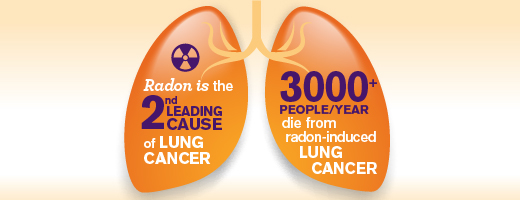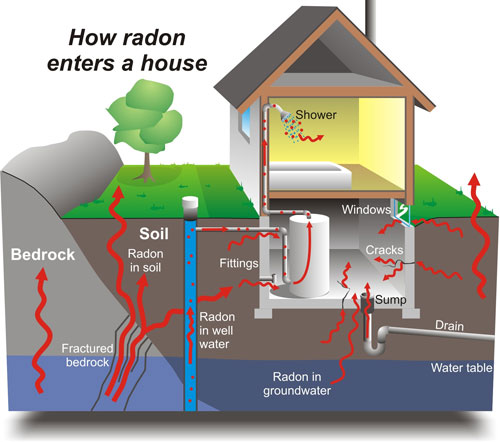Radon is a radioactive gas emitted from the soil and rock. It exists across Canada in varying amounts. You cannot see, smell or taste it, but it can accumulate to high levels in buildings, like homes, and can present a serious health risk to you and your family.
Radon is the second highest leading cause of lung cancer in Canada, responsible for 3,000 deaths each year (Health Canada) and the leading cause of lung cancer in non-smokers (Lung Cancer Canada). 
Whether you are a homeowner, buying an existing home or having a new home built, you need to learn about it and take action if needed. It gets into homes through cracks in the foundation, pipes, wells, basement windows and more. It can also be found in well water.
Builders cannot test for radon before building a home.
According to Health Canada, the acceptable level of radon in the average home is 200 becquerels per cubic metre (200 Bq/m³).
Testing your home is the only way to know if you need to act. November is Health Canada’s Radon Action Month: Buy a kit that measures radon for three months, send the kit to the lab and get results. November is the best time to start testing, so the kit can measure radon in your home during the cold months when windows and doors are most often closed. Health Canada provides links to maps, kit sources and remediation information:
https://www.canada.ca/en/health-canada/services/health-risks-safety/radiation/radon.html
https://health-infobase.canada.ca/datalab/radon-blog.html
https://www.youtube.com/watch?v=tHoITOI1d8k
| Tips related to Radon: Before signing the contract with your builder for the construction of your home, do your research and take necessary steps, e.g.,
Ask the builder you are considering purchasing from about: – any precautions they use in the construction process, for example: o do they install a venting system during construction in the event that radon is detected later? This allows easy installation of the sub slab depressurization system if needed later. o do they lay a shield beneath the foundation during construction? – if the builder will cover the cost of remediation if needed. – whether the warranty that comes with the home covers remediation work if needed. Get any builder commitments in the contract of purchase and sale.
Tips related to Radon: After taking possession of the home: – For a newly built home, Lung Cancer Canada recommends getting your home tested during the first heating season in your home. As noted above, November is Health Canada’s Radon Action Month – and you can get a kit from Health Canada. Older homes need to be tested regularly. – If you hire a company to do the testing, to avoid potential for conflict of interest, get the testing and remediation done by two different companies. – Reducing the radon in your home is possible and effective – see links above. Sealing cracks in the foundation and installing ventilation systems are common methods: Consult a professional. – While remediation may cost in the neighbourhood of $3,000, it is part of the cost of owning a home, so you should plan for it. It saves lives. |
© Department of Natural Resources Canada. All rights reserved.





